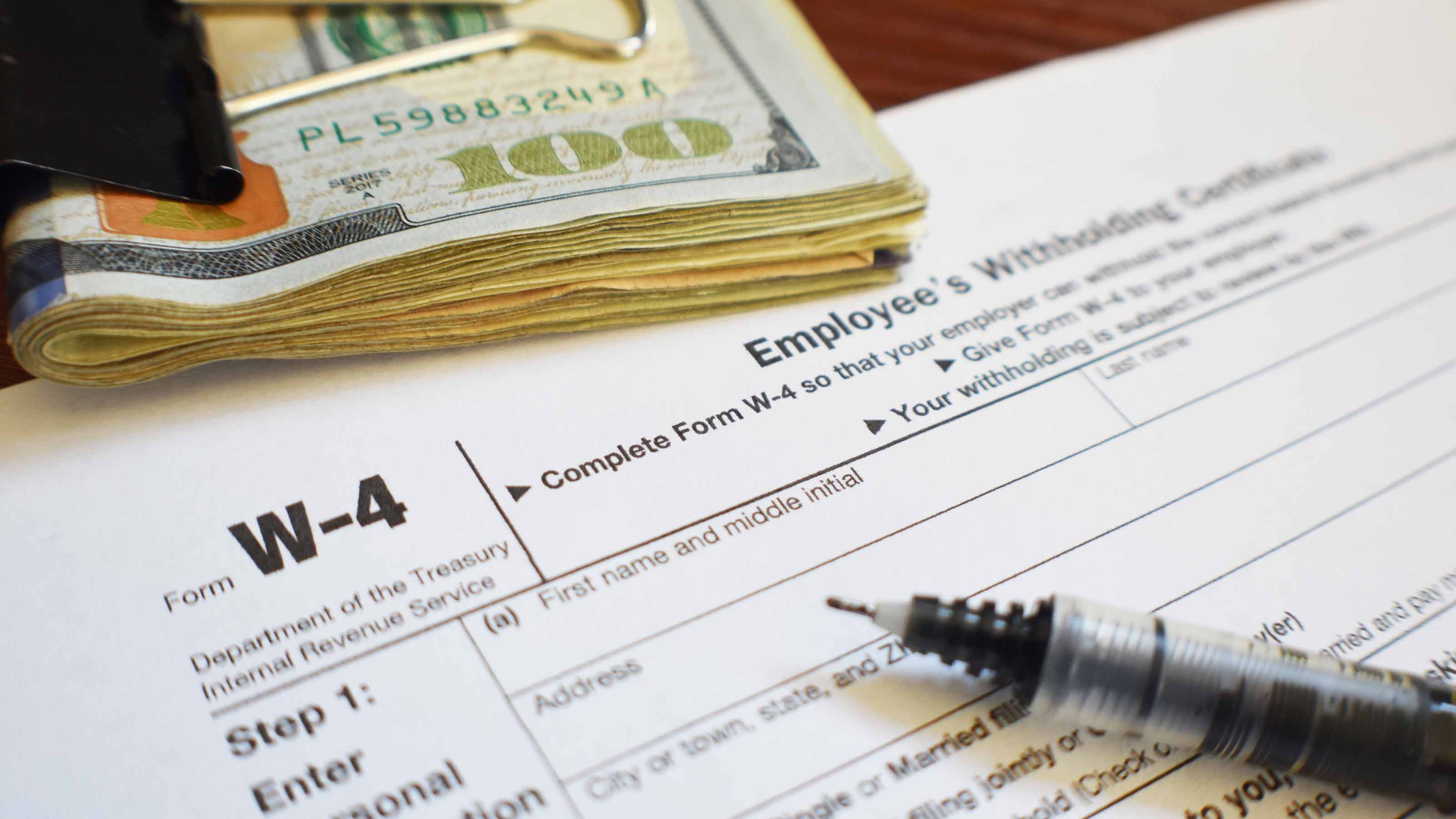Tax Withholding Changes Can Boost Your Paycheck Now and Avoid Penalties Later
There's still time to submit a new Form W-4 to change your tax withholding for the rest of the year.


Do yourself a favor: Look at your last paycheck and see how much federal income tax has been withheld from your wages so far this year. If you've had too much or too little withheld, there's still time to change your tax withholding for the rest of the year (and beyond). But, since you probably only have a couple of pay periods left this year, you need to act as soon as possible to have an impact on your overall 2022 withholding.
Making a change can put more money in your pocket now…or shield you from an IRS penalty later. The goal is to have your annual tax withholding be as close to your overall tax liability for the year. Think like Goldilocks – you want your tax withholding to be "just right."
If you have too much tax withheld during the year, your take-home pay isn't as high as it could be and you're effectively giving Uncle Sam an interest-free loan each pay period (you won't get paid back until you get your next tax refund). Reducing your tax withholding in this case will immediately boost your paycheck (it's like giving yourself a raise). And, yes, next year's tax refund will be smaller…but that just means you're not letting the government hold on to and use your money for a few months (again, without paying interest).
From just $107.88 $24.99 for Kiplinger Personal Finance
Become a smarter, better informed investor. Subscribe from just $107.88 $24.99, plus get up to 4 Special Issues

Sign up for Kiplinger’s Free Newsletters
Profit and prosper with the best of expert advice on investing, taxes, retirement, personal finance and more - straight to your e-mail.
Profit and prosper with the best of expert advice - straight to your e-mail.
On the other hand, if your employer doesn't withhold at least (1) 90% of the income tax you expect to owe for 2022, or (2) 100% of the tax you paid for 2021 (110% if your 2021 adjusted gross income was more than $150,000), you could be hit with an underpayment penalty when you file your federal tax return next April. Increasing your tax withholding now can help reduce or completely avoid this penalty. It can also lower or prevent a tax bill when you file your federal tax return next year.
File a New W-4 Form to Change Your Tax Withholding
There are many reasons why your tax withholding could be a bit off. Common causes include a marriage, divorce, birth of a child, or home purchase during the year. If it looks like your 2022 tax withholding is going to be too high or too low because of one of these or some other reason, you can submit a new Form W-4 now to increase or decrease your withholding for the rest of the year. Give the new form to your employer and they'll take it from there (check with your HR department to find out exactly who you should send the form to). Your employer must implement any change by the start of the first payroll period ending on or after the 30th day after you submit a new W-4 form for this year.
Although there are five "steps" on the W-4 form, only Step 1 (name, address, Social Security number and filing status) and Step 5 (sign and date) are required for everyone. You only have to complete Steps 2 to 4 if they apply to you (e.g., you have more than one job, a spouse that works, dependents or other adjustments). Completing all relevant steps will bring your tax withholding closer to your tax liability, which (again) is the goal.
If you just want to increase your withholding, one easy way to do this is to specify an extra amount you'd like to have withheld from your paycheck on Line 4(c) of the W-4 form.
IRS's Withholding Tax Calculator
To help you determine if and/or how much to adjust your 2022 withholding, use the IRS's Tax Withholding Estimator as soon as you can. Have your most recent pay stub and a copy of your 2021 tax return handy to help estimate your 2022 income. Again, you must act quickly, since we're almost to the end of the year.
We also recommend using the tax withholding calculator early in 2023 to see if additional adjustments are beneficial going forward. In fact, it's a good idea to check your withholding every year. And the earlier in the year you do it – and make any necessary changes – the better. That way your tax withholding will be more even and accurate throughout the year.
But remember that you aren't required to submit a new W-4 form to your employer unless you're starting a new job. If your company doesn't receive a new form from you, it will just continue to withhold taxes based on the most recent W-4 it has on file for you.
Profit and prosper with the best of Kiplinger's advice on investing, taxes, retirement, personal finance and much more. Delivered daily. Enter your email in the box and click Sign Me Up.
Rocky Mengle was a Senior Tax Editor for Kiplinger from October 2018 to January 2023 with more than 20 years of experience covering federal and state tax developments. Before coming to Kiplinger, Rocky worked for Wolters Kluwer Tax & Accounting, and Kleinrock Publishing, where he provided breaking news and guidance for CPAs, tax attorneys, and other tax professionals. He has also been quoted as an expert by USA Today, Forbes, U.S. News & World Report, Reuters, Accounting Today, and other media outlets. Rocky holds a law degree from the University of Connecticut and a B.A. in History from Salisbury University.
-
 Holiday Tax Scams: 'Tis the Season to be Wary
Holiday Tax Scams: 'Tis the Season to be WaryTax Scams Navigating tax tricks of the holiday season may be daunting, but don't let that destroy your festive spirit
-
 Metro by T-Mobile Is Giving Away This Samsung Galaxy A16: Which Plans Are Eligible?
Metro by T-Mobile Is Giving Away This Samsung Galaxy A16: Which Plans Are Eligible?Metro by T-Mobile is offering free Samsung Galaxy A16 phones on eligible plans right now. Here’s how the deal works.
-
 I Drive and Collect Classic Cars: Here’s How I Got Started
I Drive and Collect Classic Cars: Here’s How I Got StartedAre classic cars a hobby or an investment strategy — or both? Either way, the vintage car scene is much cooler and more affordable than you think.
-
 Holiday Tax Scams: 'Tis the Season to be Wary
Holiday Tax Scams: 'Tis the Season to be WaryTax Scams Navigating tax tricks of the holiday season may be daunting, but don't let that destroy your festive spirit
-
 Retirees in These 7 States Could Pay Less Property Taxes Next Year
Retirees in These 7 States Could Pay Less Property Taxes Next YearState Taxes Retirement property tax bills could be up to 65% cheaper for some older adults in 2026. Do you qualify?
-
 Estate Tax Quiz: Can You Pass the Test on the 40% Federal Rate?
Estate Tax Quiz: Can You Pass the Test on the 40% Federal Rate?Quiz How well do you know the new 2026 IRS rules for wealth transfer and the specific tax brackets that affect your heirs? Let's find out!
-
 Law Reversal Looming? Trump Eyes 2026 Gambling Winnings Tax Change
Law Reversal Looming? Trump Eyes 2026 Gambling Winnings Tax ChangeTax Deductions It's no secret that the IRS is coming after your gambling winnings in 2026. But how long will that last?
-
 5 Types of Gifts the IRS Won’t Tax: Even If They’re Big
5 Types of Gifts the IRS Won’t Tax: Even If They’re BigGift Tax Several categories of gifts don’t count toward annual gift tax limits. Here's what you need to know.
-
 The 'Scrooge' Strategy: How to Turn Your Old Junk Into a Tax Deduction
The 'Scrooge' Strategy: How to Turn Your Old Junk Into a Tax DeductionTax Deductions We break down the IRS rules for non-cash charitable contributions. Plus, here's a handy checklist before you donate to charity this year.
-
 IRS Says You Made a Tax Return Mistake? A New Law Could Help You Fight Back
IRS Says You Made a Tax Return Mistake? A New Law Could Help You Fight BackTax Law Updated taxpayer protections change what the IRS must explain on error notices and how long you have to respond.
-
 Tax Refund Alert: House GOP Predicts 'Average' $1,000 Payouts in 2026
Tax Refund Alert: House GOP Predicts 'Average' $1,000 Payouts in 2026Tax Refunds Here's how the IRS tax refund outlook for 2026 is changing and what steps you can take now to prepare.
